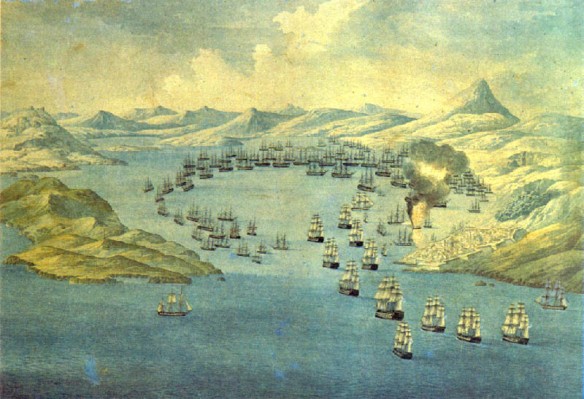The Great Age of Fighting had then passed its peak, and there would be only one more large sailing fleet battle, the one-sided slaughter of an Egyptian-Turkish squadron by a combined fleet composed of British, French, and Russian warships at Navarino Bay in 1827. The forces were not large: 11 allied battleships and 16 other ships faced seven Turkish battleships and 58 smaller ships.
The last great naval battle of the sailing ship era arose out of the Greek War of Independence, 1822-32. In an attempt to control the conflict Britain joined France and Russia, which had wider ambitions. When Sir Edward Codrington led the combined fleets into Navarino Bay on 20 October 1827 determined to forestall a Turkish attack on the Greek island of Hydra, battle was inevitable. The numerous but smaller ships of the Turco-Egyptian fleet were almost annihilated in a savage close-range battle by the superior firepower of the allied ships, especially Codrington’s flagship the new 84-gun Asia. While a new ministry in London considered Navarino ‘untoward’ and sacked Codrington, the French and Russians celebrated a rare victory.
A Turco-Egyptian force took the Acropolis, arousing pro-Greek public and political opinion throughout Europe. The governments of Britain and France felt compelled to intervene in the conflict, to save the Greeks from total defeat and also to forestall a unilateral intervention by Russia, more likely under the new tsar, Nicholas I, who had succeeded Alexander I at the end of 1825. In the Treaty of London (7 July 1827), Britain, France, and Russia agreed to send squadrons to Greek waters to force an end to the conflict. The Russian navy’s first ships to enter the Mediterranean since 1807 had to come from the Baltic, as the Black Sea fleet could not pass through the Turkish straits. Upon arrival the allies blockaded the coast of the Morea and demanded an Egyptian evacuation. When the Egyptian commander, Mehemet Ali’s son Ibrahim, refused to capitulate, Vice Admiral Sir Edward Codrington led an allied force into Navarino Bay, chief anchorage of the Turco-Egyptian fleet, Russia and France each contributed four ships of the line, Britain three, while Russia and Britain each sent four frigates, France one. Six smaller warships rounded out Codrington’s formidable fleet. Accounts of Ibrahim’s order of battle vary dramatically but, counting ships as small as brigs, he had around sixty-five warships, including seven ships of the line and fifteen frigates. His fleet was anchored along the shore in three concentric semicircles, against which Codrington’s ships formed a semicircle of their own, blocking the entrance to the bay. Codrington had no instructions to destroy the Turco-Egyptian fleet, but a battle erupted as the allies entered the bay on 20 October 1827, just before the last of the Russian ships had taken their positions. Under circumstances that remain unclear, Ibrahim’s warships apparently opened fire on small boats sent out by the British and French, prompting the entire allied fleet to return fire. In two-and-a-half hours of battle the allied superiority in ships of the line proved decisive, as their broadsides did most of the work in sinking one ship of the line, twelve frigates, twenty-two corvettes, and nineteen brigs, in the process killing 7,000 of Ibrahim’s sailors. The allies lost no ships but suffered casualties of 177 killed and almost 500 wounded.
As a naval battle, Navarino was notable for two reasons: for the first time since the 1670s, the British and French navies fought on the same side, and for the last time in history, a major engagement included sailing ships alone. The allies also succeeded where Miaoulis and Cochrane had failed, crushing the naval power essential to the sultan’s reconquest of Greece. In January 1828 Count Ioannis Capodistrias, former foreign minister of Russia, assumed the presidency of a Greek republic whose independence was recognized by international treaty two years later. Cochrane clashed almost immediately with Capodistrias and grew disenchanted with the Greek leaders in general, characterizing them as “double-dealing knaves.” He resigned in November 1828 and sailed home to Britain. The return to power of the Whigs in 1830 paved the way for his political rehabilitation, and two years later the British navy restored his commission.
The Turks were now unable to move their troops by water, but continued to fight on until November 1828 when a French land force finally took their last stronghold on the Morea. The Russian Black Sea fleet supported the army’s advance against Turkish positions at Varna on the Danube. Blockades of Turkish-held positions in the Black Sea, the Mediterranean and at Constantinople were established. British and French naval power was used to prevent the Russian conquest of Constantinople and encourage an armistice.
